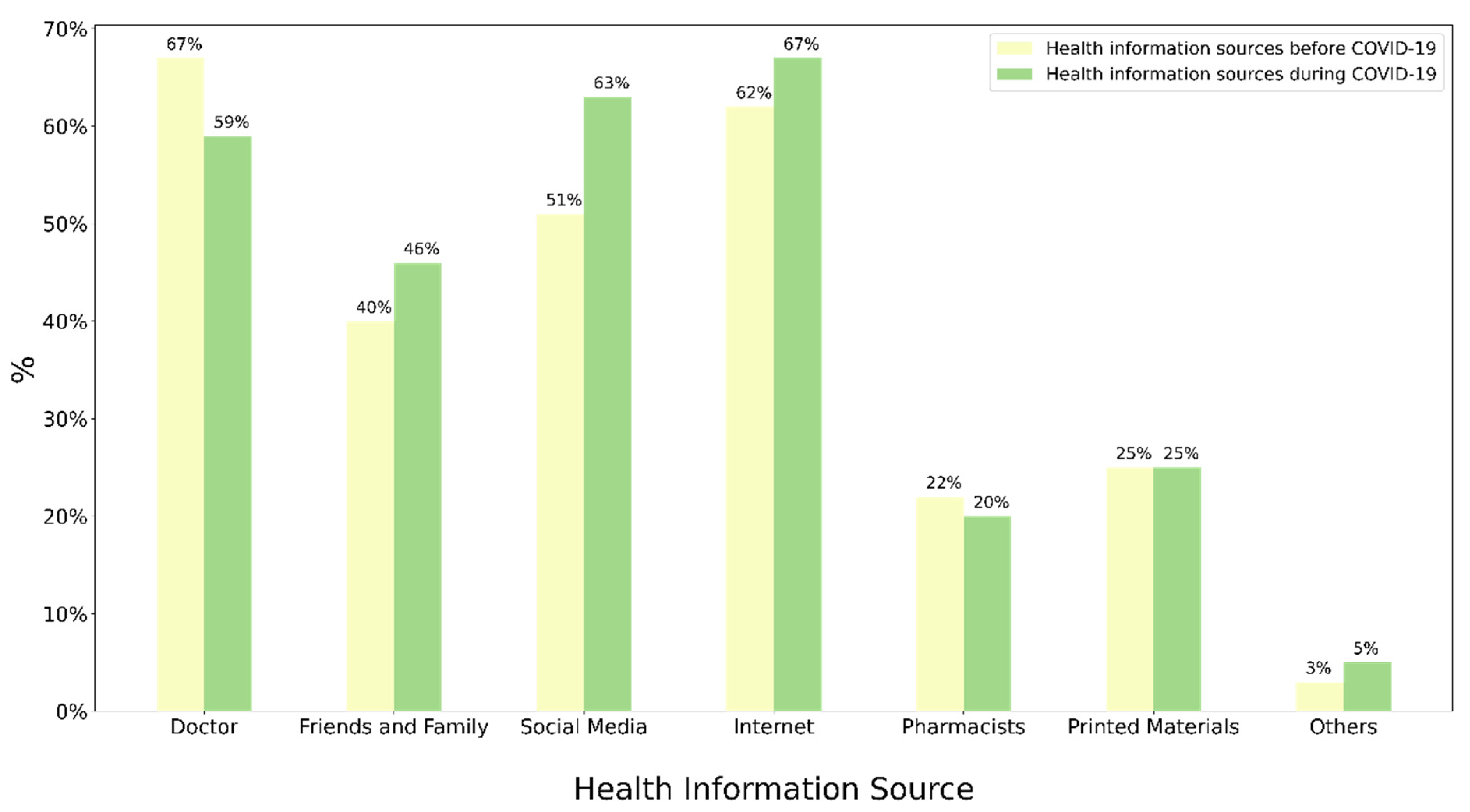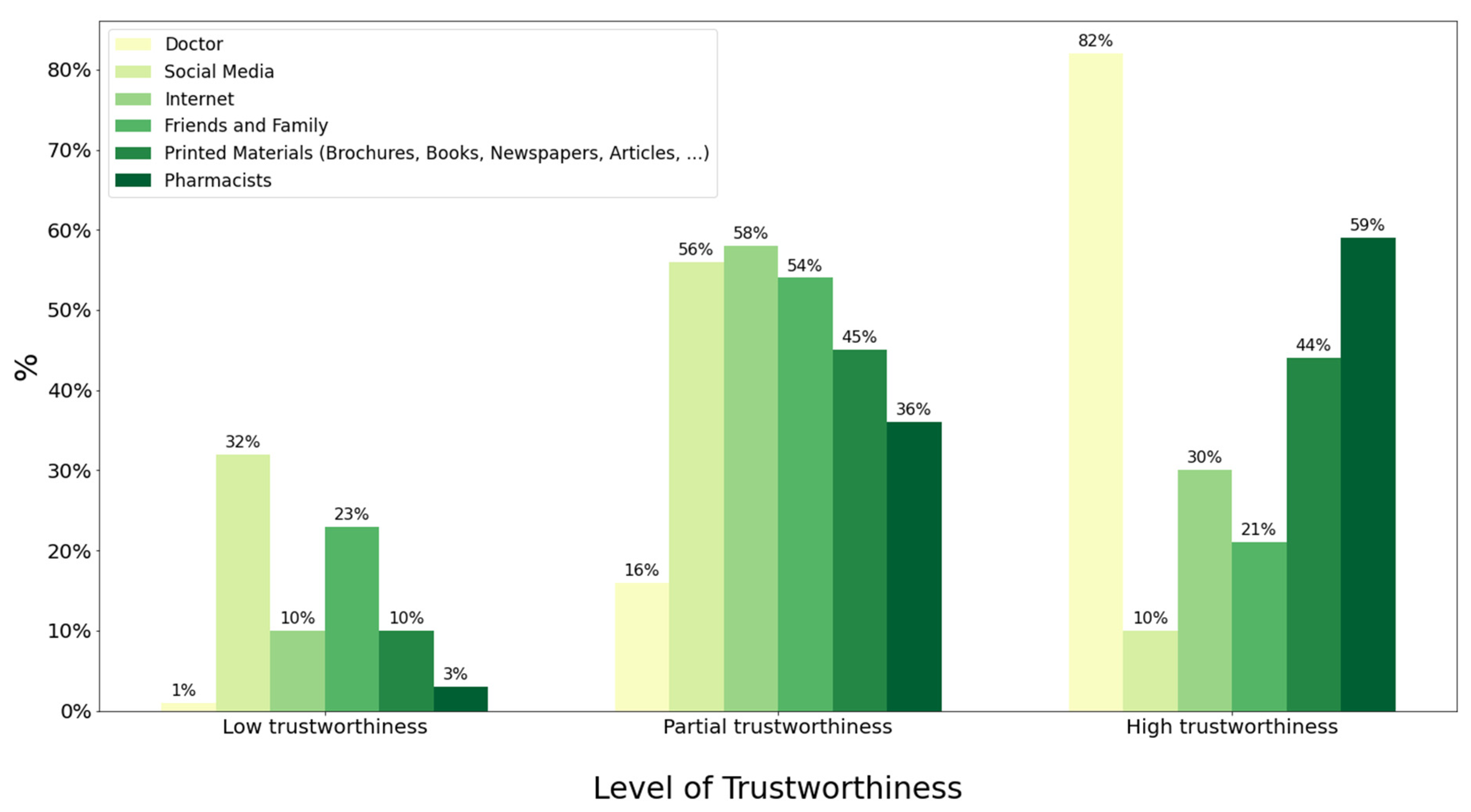The Usage and Trustworthiness of Various Health Information Sources in the United Arab Emirates: An Online National Cross-Sectional Survey
Abstract
1. Introduction
2. Methodology
2.1. Study Design and Target Population
2.2. Questionnaire Development
2.3. Sampling and Data Collection
2.4. Data Entry and Analysis
3. Results
3.1. Demographics
3.2. Sources of Health Information
3.2.1. Usage of Health Information Sources
3.2.2. Trustworthiness of Health Information Sources
4. Discussion
Limitations
5. Conclusions
Supplementary Materials
Author Contributions
Funding
Institutional Review Board Statement
Informed Consent Statement
Data Availability Statement
Conflicts of Interest
References
- Alduraywish, S.A.; Altamimi, L.A.; Aldhuwayhi, R.A.; AlZamil, L.R.; Alzeghayer, L.Y.; Alsaleh, F.S.; Aldakheel, F.M.; Tharkar, S. Sources of Health Information and Their Impacts on Medical Knowledge Perception Among the Saudi Arabian Population: Cross-Sectional Study. J. Med. Internet Res. 2020, 22, e14414. [Google Scholar] [CrossRef]
- AlGhamdi, K.M.; Moussa, N.A. Internet use by the public to search for health-related information. Int. J. Med. Inform. 2012, 81, 363–373. [Google Scholar] [CrossRef] [PubMed]
- Ashkanani, H.; Asery, R.; Bokubar, F.; AlAli, N.; Mubarak, S.; Buabbas, A.; Almajran, A. Web-Based Health Information Seeking Among Students at Kuwait University: Cross-Sectional Survey Study. JMIR Form. Res. 2019, 3, e14327. [Google Scholar] [CrossRef] [PubMed]
- Baheiraei, A.; Khoori, E.; Foroushani, A.R.; Ahmadi, F.; Ybarra, M.L. What sources do adolescents turn to for information about their health concerns? Int. J. Adolesc. Med. Health 2014, 26, 61–68. [Google Scholar] [CrossRef] [PubMed]
- Carpenter, D.M.; DeVellis, R.F.; Hogan, S.L.; Fisher, E.B.; DeVellis, B.M.; Jordan, J.M. Use and Perceived Credibility of Medication Information Sources for Patients with a Rare Illness: Differences by Gender. J. Health Commun. 2011, 16, 629–642. [Google Scholar] [CrossRef]
- Charan, J.; Biswas, T. How to Calculate Sample Size for Different Study Designs in Medical Research? Indian J. Psychol. Med. 2013, 35, 121–126. [Google Scholar] [CrossRef]
- Chen, Y.; Li, C.; Liang, J.; Tsai, C. Health information obtained from the internet and changes in medical decision making: Questionnaire development and cross-sectional survey [serial online]. J. Med. Internet Res. 2018, 20, e47. [Google Scholar] [CrossRef]
- Choudhury, S.M.; Arora, T.; Alebbi, S.; Ahmed, L.; Aden, A.; Omar, O.; Taheri, S. How Do Qataris Source Health Information? PLoS ONE 2016, 11, e0166250. [Google Scholar] [CrossRef]
- Clarke, M.A.; Moore, J.L.; Steege, L.M.; Koopman, R.J.; Belden, J.L.; Canfield, S.M.; Meadows, S.E.; Elliott, S.G.; Kim, M.S. Health information needs, sources, and barriers of primary care patients to achieve patient-centered care: A literature review. Health Inform. J. 2016, 22, 992–1016. [Google Scholar] [CrossRef]
- Dutta-Bergman, M.J. Health attitudes, health cognitions, and health behaviors among Internet health information seekers: Population-based survey(Electronic Version). J. Med. Internet Res. 2004, 6, e15. [Google Scholar] [CrossRef]
- Figueiras, M.J.; Ghorayeb, J.; Coutinho, M.V.C.; Marôco, J.; Thomas, J. Levels of Trust in Information Sources as a Predictor of Protective Health Behaviors During COVID-19 Pandemic: A UAE Cross-Sectional Study. Front. Psychol. 2021, 12, 633550. [Google Scholar] [CrossRef]
- Fiksdal, A.S.; Kumbamu, A.; Jadhav, A.S.; Cocos, C.; Nelsen, L.A.; Pathak, J.; McCormick, J.B. Evaluating the process of online health information searching: A qualitative approach to exploring consumer perspectives. J. Med. Internet Res. 2014, 16, e224. [Google Scholar] [CrossRef]
- Ghweeba, M.; Lindenmeyer, A.; Shishi, S.; Abbas, M.; Waheed, A.; Amer, S. What Predicts Online Health Information-Seeking Behavior Among Egyptian Adults? A Cross-Sectional Study. J. Med. Internet Res. 2017, 19, e216. [Google Scholar] [CrossRef] [PubMed]
- Greyson, D. Health information practices of young parents. J. Doc. 2017, 73, 778–802. [Google Scholar] [CrossRef]
- Jacobs, W.; Amuta, A.O.; Jeon, K.C. Health information seeking in the digital age: An analysis of health information seeking behavior among US adults. Cogent Soc. Sci. 2017, 3, 1302785. [Google Scholar] [CrossRef]
- Jamal, A.; Khan, S.A.; AlHumud, A.; Al-Duhyyim, A.; Alrashed, M.; Bin Shabr, F.; Alteraif, A.; Almuziri, A.; Househ, M.; Qureshi, R. Association of Online Health Information–Seeking Behavior and Self-Care Activities Among Type 2 Diabetic Patients in Saudi Arabia. J. Med. Internet Res. 2015, 17, e196. [Google Scholar] [CrossRef] [PubMed]
- Kontos, E.; Blake, K.D.; Chou, W.S.; Prestin, A. Predictors of eHealth Usage: Insights on The Digital Divide From the Health Information National Trends Survey 2012. J. Med. Internet Res. 2014, 16, e172. [Google Scholar] [CrossRef]
- Mills, A.; Todorova, N. An Integrated Perspective on Factors Influencing Online Health-Information Seeking Behaviours. 2016. Available online: http://hdl.handle.net/10092/100781 (accessed on 11 October 2022).
- Powell, J.; Inglis, N.; Ronnie, J.; Large, S. The characteristics and motivations of online health information seekers: Cross-sectional survey and qualitative interview study. J. Med. Internet Res. 2011, 13, e20. [Google Scholar] [CrossRef]
- Ramsey, I.; Corsini, N.; Peters, M.D.J.; Eckert, M. A rapid review of consumer health information needs and preferences. Patient Educ. Couns. 2017, 100, 1634–1642. [Google Scholar] [CrossRef]
- Samara, K.A.; Barqawi, H.J.; Aboelsoud, B.H.; AlZaabi, M.A.; Alraddawi, F.T.; Mannaa, A.A. Hepatitis A virus knowledge and immunization attitudes and practices in the United Arab Emirates community. Sci. Rep. 2021, 11, 2651. [Google Scholar] [CrossRef]
- Sbaffi, L.; Rowley, J. Trust and credibility in web-based health information: A review and agenda for future research. J. Med. Internet Res. 2017, 19, e218. [Google Scholar] [CrossRef] [PubMed]
- Simou, E. Health information sources: Trust and satisfaction. Int. J. Healthc. 2015, 2, 38–43. [Google Scholar] [CrossRef]
- Sultan, K.; Riju Joshua, V.; Misra, U. Health Information Seeking Behavior of College Students in the Sultanate of Oman. KUST Med. J. 2017, 9, 8–14. [Google Scholar]
- Williams, S.L.; Ames, K.; Lawson, C. Preferences and trust in traditional and non-traditional sources of health information—A study of middle to older aged Australian adults. J. Commun. Healthc. 2019, 12, 134–142. [Google Scholar] [CrossRef]
- Zhao, X.; Fan, J.; Basnyat, I.; Hu, B. Online Health Information Seeking Using “#COVID-19 Patient Seeking Help” on Weibo in Wuhan, China: Descriptive Study. J. Med. Internet Res. 2020, 22, e22910. [Google Scholar] [CrossRef]
- Zhao, Y.; Zhang, J. Consumer health information seeking in social media: A literature review. Health Inf. Libr. J. 2017, 34, 268–283. [Google Scholar] [CrossRef]


| Feature | n (%) | Feature | n (%) |
|---|---|---|---|
| Sex | Field of Work | ||
| Female | 683 (63.07%) | Healthcare | 112 (10.34%) |
| Male | 400 (36.93%) | Non-healthcare | 364 (33.61%) |
| Highest Degree Obtained | Student (health-related majors) | 274 (25.3%) | |
| High school or lower | 410 (37.86%) | Student (non-health-related majors) | 149 (13.76%) |
| Diploma/bachelor’s degree | 574 (53.0%) | Housewife | 98 (9.05%) |
| Postgraduate degree (MSc, Ph.D., etc.) or higher | 99 (9.14%) | Unemployed | 86 (7.94%) |
| Age | Health Insurance | ||
| 18 or below | 124 (11.45%) | No | 294 (27.15%) |
| 19 to 29 | 545 (50.32%) | Yes | 789 (72.85%) |
| 30 to 39 | 159 (14.68%) | Health Rating | |
| 40 or above | 255 (23.55%) | Average or below | 216 (19.94%) |
| Marital Status | Better than average | 867 (80.06%) | |
| Married | 392 (36.2%) | Health Literacy | |
| Unmarried | 691 (63.8%) | Limited reading ability | 350 (32.32%) |
| Nationality | Normal reading ability | 733 (67.68%) | |
| UAE national | 355 (32.78%) | Long-term Medical Conditions | |
| Other Arab | 535 (49.4%) | No | 913 (84.3%) |
| Non-Arab | 193 (17.82%) | Yes | 170 (15.7%) |
| Place of Residence | Frequency of Internet Usage as a Health Information Source | ||
| Abu Dhabi | 189 (17.45%) | Below average | 107 (9.88%) |
| Dubai | 261 (24.1%) | Average | 238 (21.98%) |
| Sharjah and other northern emirates | 633 (58.45%) | Above average | 738 (68.14%) |
| Determinants of Internet Use-Binary Logistic Regression (LR) | ||||||
|---|---|---|---|---|---|---|
| Model Terms | 95% CI for OR | SE | z-Statistic | p-Value | ||
| ) | 2.579 | 1.351–4.918 | 0.330 | 2.874 | 0.004 | |
| Long-term medical conditions | No | - | - | - | - | - |
| Yes | 0.707 | 0.495–1.012 | 0.183 | −1.896 | 0.058 | |
| Age | Younger than or equal to 18 years | - | - | - | - | - |
| Between 19 and 29 years, inclusive | 1.401 | 0.900–2.179 | 0.225 | 1.495 | 0.135 | |
| Between 30 and 39 years, inclusive | 2.092 | 1.051–4.162 | 0.351 | 2.102 | 0.036 | |
| 40 years or older | 2.260 | 1.131–4.513 | 0.353 | 2.308 | 0.021 | |
| Place of Residence | Sharjah and other northern emirates | - | - | - | - | - |
| Abu Dhabi | 1.423 | 0.969–2.092 | 0.196 | 1.798 | 0.072 | |
| Dubai | 1.038 | 0.754–1.430 | 0.164 | 0.230 | 0.818 | |
| Marital Status | Unmarried | - | - | - | - | - |
| Married | 0.464 | 0.280–0.769 | 0.257 | −2.984 | 0.003 | |
| Health Literacy | Limited Reading Ability | - | - | - | - | - |
| Normal Reading Ability | 1.101 | 0.828–1.464 | 0.146 | 0.658 | 0.510 | |
| Occupation | Healthcare (nurses, doctors, dentists, pharmacists, healthcare administration, etc.) | - | - | - | - | - |
| Housewife | 0.663 | 0.345–1.275 | 0.334 | −1.232 | 0.218 | |
| Non-healthcare | 0.567 | 0.335–0.960 | 0.268 | −2.114 | 0.034 | |
| Student—health-related majors | 0.882 | 0.509–1.528 | 0.281 | −0.449 | 0.654 | |
| Student—other non-health-related majors | 0.525 | 0.289–0.957 | 0.306 | −2.104 | 0.035 | |
| Unemployed | 0.386 | 0.206–0.725 | 0.322 | −2.959 | 0.003 | |
| Log-Likelihood: −655.80 | Log-Likelihood of Null Model: −677.72 | Log-Likelihood Ratio p-value: <0.0005 | ||||
Disclaimer/Publisher’s Note: The statements, opinions and data contained in all publications are solely those of the individual author(s) and contributor(s) and not of MDPI and/or the editor(s). MDPI and/or the editor(s) disclaim responsibility for any injury to people or property resulting from any ideas, methods, instructions or products referred to in the content. |
© 2023 by the authors. Licensee MDPI, Basel, Switzerland. This article is an open access article distributed under the terms and conditions of the Creative Commons Attribution (CC BY) license (https://creativecommons.org/licenses/by/4.0/).
Share and Cite
Almaazmi, M.A.; Samara, K.A.; Jarai, M.; Majeed, H.; Barqawi, H.J. The Usage and Trustworthiness of Various Health Information Sources in the United Arab Emirates: An Online National Cross-Sectional Survey. Healthcare 2023, 11, 663. https://doi.org/10.3390/healthcare11050663
Almaazmi MA, Samara KA, Jarai M, Majeed H, Barqawi HJ. The Usage and Trustworthiness of Various Health Information Sources in the United Arab Emirates: An Online National Cross-Sectional Survey. Healthcare. 2023; 11(5):663. https://doi.org/10.3390/healthcare11050663
Chicago/Turabian StyleAlmaazmi, Mariam A., Kamel A. Samara, Mohammed Jarai, Hussain Majeed, and Hiba J. Barqawi. 2023. "The Usage and Trustworthiness of Various Health Information Sources in the United Arab Emirates: An Online National Cross-Sectional Survey" Healthcare 11, no. 5: 663. https://doi.org/10.3390/healthcare11050663
APA StyleAlmaazmi, M. A., Samara, K. A., Jarai, M., Majeed, H., & Barqawi, H. J. (2023). The Usage and Trustworthiness of Various Health Information Sources in the United Arab Emirates: An Online National Cross-Sectional Survey. Healthcare, 11(5), 663. https://doi.org/10.3390/healthcare11050663






